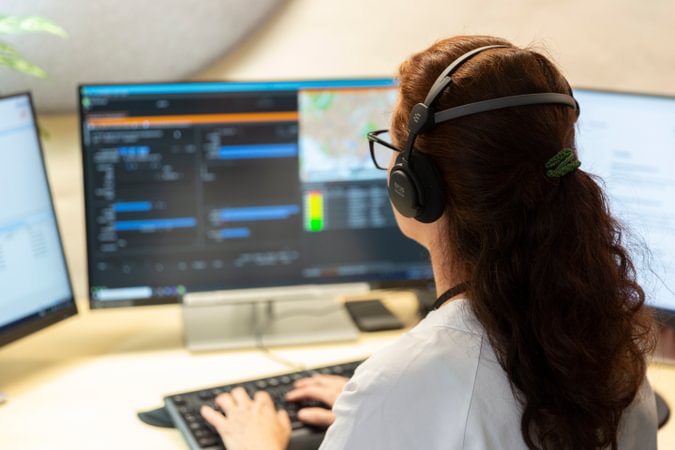Computer Aided Dispatch Systems
Computer Aided Dispatch (CAD) systems empower emergency services to process and respond to incidents in the most efficient and effective way possible. A central component of any modern emergency response system, they provide dispatchers and incident managers with a purpose-built tool for monitoring and managing accidents and emergencies.
Understanding Computer Aided Dispatch Systems
Computer Aided Dispatch systems are digital solutions that enable emergency service call takers and dispatchers to receive incoming calls, record critical information and manage emergency response and resource dispatch. In many instances, they facilitate collaboration between emergency service agencies, including the police, fire and ambulance services, enabling a comprehensive and coordinated response.
Also regularly referred to as Computer Assisted Dispatch systems, these digital platforms vary in complexity, with basic solutions limiting themselves to call-taking, call-logging, resource dispatch and emergency asset monitoring. At the other end of the spectrum, more extensive solutions provide emergency services with detailed operational oversight, support data-based decision-making and provide the tools to manage every aspect of an incident.

Critical Computer Aided Dispatch system features
Modern CAD systems are powerful digital solutions that provide emergency organisations with the information, insight and capacity to respond to incidents effectively. We can categorise the key features that facilitate this response into four core areas.
Communication infrastructure
Computer Aided Dispatch systems require secure and reliable communication infrastructure that enables emergency services to receive calls from the general public. This infrastructure also provides the means for inter-agency communication and transmissions between individual actors, such as call dispatchers, frontline emergency responders and incident managers.
While system stability and dependability are essential, CAD communication infrastructure should also incorporate features like multi-party conference calling, call monitoring and recording, and multimedia communication capabilities. As emergency services move to leverage an increasingly diverse range of data, including photo, video, text and location data, the ability to process different types of information will become a defining feature of high-quality solutions.
Operational awareness
Industry-leading CAD systems provide emergency services with detailed operational oversight, enabling them to make informed decisions and better manage incidents. Often, systems achieve this via mapping support and associated features. For instance, streamlined address and route search processes enable quicker and more accurate dispatch, while multi-layer mapping functionality ensures emergency services have the best possible understanding of the incident environment and can utilise all available geo-information.
Crucially, advanced CAD solutions guarantee all relevant actors share a common operational perspective, enhancing coordination and enabling all responders to work from the same assumptions and information.
Incident handling
Modern Computer Aided Dispatch systems must also feature support for the responders responsible for managing incidents. This includes efficient systems for handling and triaging incidents, as well as workflow support during call-taking. Intelligent workflows guide dispatchers through their responses, providing interview and medical decision-making support. Support is often extremely valuable, as dispatchers typically receive no medical training, and their call categorisation will determine which resources are dispatched to an incident.
Dispatch support
Finally, CAD systems also assist with effective dispatch decision-making by supporting responders when allocating appropriate resources. While under-categorisation results in the dispatch of inadequate emergency resources and potentially endangers those requiring emergency assistance, over-categorisation is a poor use of emergency resources.
In environments where emergency assets are scarce and frontline personnel are under considerable strain, over-categorisation exacerbates the situation. Consequently, CAD systems should promote efficient resource utilisation. In some operational contexts, CAD solutions will also facilitate automatic dispatch.
The future of Computer Assisted Dispatch software
Computer Assisted Dispatch systems are undergoing significant innovation, with several developments, most notably Internet of Things (IoT) and AI technologies, having a sizable impact. For instance, Omda, Valencia EMS and a team from the University of Valencia have collaborated on an AI-assisted dispatch tool that utilises AI technology for more accurate call categorisation, to support improved healthcare outcomes and optimised resource use.
The European Emergency Number Association’s (EENA) NG112 project also emphasises the importance of new data types to emergency services. It promotes the development of a common, flexible emergency services solution architecture to facilitate the use of this information, which will include text, video and location data, as well as data collected from proliferating IoT devices.
Other recent developments include zero downtime features. For many emergency services, CAD failure means resorting to pen-and-paper systems. This also occurs when the systems require maintenance or updating. Omda’s recently developed Continuous Operation feature provides emergency services with two parallel systems that draw on the same databases. It enables the organisation to use one system while updating the other and to switch across to complete the process, eliminating maintenance-related downtime and allowing for more regular updates.
Omda computer aided dispatch systems
At Omda, our Omda Incident portfolio includes two principal CAD systems. Among others, the Valencia 112 organisation in Spain utilises Omda Incident (CoordCom) and Omda Incident (AMIS) is deployed in Norway’s national Emergency Medical Control Centres (EMCCs) and casualty clinics (legevaktsentraler).
Valencia 112 uses Omda Incident (CoordCom) to process more than 8,200 calls every day, manage 4,200 different resources and coordinate action between 120 emergency agencies, including police, ambulance and fire services. A highly specialised solution, it has evolved to meet Valencia 112’s specific operational needs and is the product of a technology partnership that spans more than 20 years. As such, it is an excellent example of Omda’s commitment to long-term product development and emphasis on user-focused design.
Omda Incident (AMIS) is utilised by Norway’s casualty clinics and out-of-hours healthcare services to handle emergency calls and coordinate a response. It features extensive workflow support for more accurate patient assessment, enabling a faster response and more efficient call handling. By providing instant access to electronic patient and summary care records, it offers call-takers and emergency responders a more comprehensive understanding of a patient’s medical history and current condition. It also incorporates analytics support and enables the creation of detailed reports that contribute to more efficient service delivery.
Head to the Omda Emergency page to learn more about Omda’s Computer Aided Dispatch systems.
Get in touch
tef.jansma@omda.com
